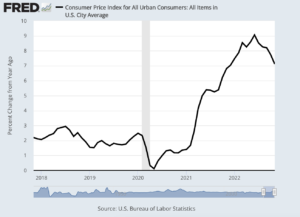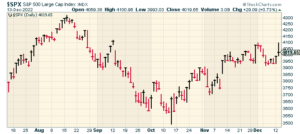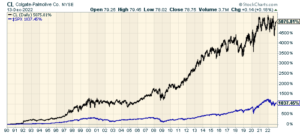CWS Market Review – December 13, 2022
“When you combine ignorance and leverage, you get some pretty interesting results.” – Warren Buffett
Stay Tuned for the 2023 Buy List
Before I get to today’s newsletter, be sure to circle your calendar for December 27, two weeks from today. That’s when I’ll unveil the 25 stocks for our 2023 Buy List. This will be the 18th year that I’ve published our Buy List.
As usual, five new stocks will go into the Buy List and five old stocks will come out. For record-keeping purposes, all the changes are made as of the close of trading on Friday, December 30 which is the final trading day of the year.
I announce our changes a few days before the end of the year so no one can say I’m trying to “game” the results.
The new Buy List will go into effect on the first trading day of the new year which is Tuesday, January 3. All of our stocks will start the year equally weighted, meaning each stock will have a 4% weighting in the portfolio based on the year-end closing prices. We assume the Buy List is always 100% invested.
As of now, it looks like 2022 will be a very good year for our Buy List, at least in relative terms. Not including dividends, our Buy List is down about 7% this year while the S&P 500 is down by 16%. The final numbers will be dividend-adjusted. We’ve done especially well versus the market over the last two months.
It may sound odd to celebrate being down by less, but it’s an important thing to do for long-term success. We had a similar year in 2008 when the stock market fell sharply.
If you own the ETF, you don’t have to do anything. The portfolio changes will happen automatically inside the shares.
Wall Street Jumps on the Good CPI Report
Wall Street had been waiting for this day for a few weeks. This was the start of the latest Fed meeting, and it’s also the day the government reported on inflation for the month of November.
The report was a good one. It was especially good news because there had been hints and suggestions that inflation was cooling off. Now we have solid proof.
Let’s get to the numbers. The government said that headline inflation rose by 0.1% last month. Wall Street had been expecting an increase of 0.3%.
Over the last year, inflation is up by 7.1%. This is the fifth month in a row that the year-over-year inflation rate has ticked down. In June, the 12-month inflation rate was 9.1%.

The core rate was also well behaved. Wall Street had been expecting the core rate to rise by 0.3% for November. Instead, it only rose by 0.2%. Over the last year, the core rate has increased by 6.0%. The 12-month core rate had peaked in September at 6.6%. Again, the trends are going in the right direction.
Most important is that inflation-adjusted wages rose by 0.5% in November. Wages are still down in real terms over the last year.
Falling energy prices helped keep inflation at bay. The energy index declined 1.6% for the month, due in part to a 2% decrease in gasoline. Food prices, however, rose 0.5% and were up 10.6% from a year ago. Even with its monthly decline, the energy index was higher by 13.1% from November 2021.
Shelter costs, which make up about one-third of CPI weighting, continued to escalate, rising 0.6% on the month and now up 7.1% on an annual basis.
Initially, the Fed dismissed inflation as being transitory. As the evidence became clear that inflation was hanging around, the Fed become more aggressive in fighting back with higher interest rates. Fed Chairman Jerome Powell said that the Fed will pay close attention to services inflation excluding shelter costs. That was mostly unchanged last month.
Medical care services fell by 0.7% in November. Used car prices dropped 2.9% last month. That had been one of the areas with the worst inflation. The problem was that a shortage of microchips caused a backlog in car production so folks snapped up used cars. Not that long ago, used car prices were up 40% year-over-year. Now used car prices are down for the year. The free market can take care of problems quickly.
Charlie Bilello points out that the average price of a used Tesla is now over $12,000 lower than the peak in July. Not surprisingly, shares of Tesla just hit a two-year low. Poor Elon is no longer the richest man in the world.
The Fed’s Next Move
The battle against inflation isn’t over, but the trend is certainly moving in the right direction.
The promise for lower interest rates is exactly what the stock market wants to hear. Sure enough, the stock market loved the inflation report. As soon as the market opened, traders pushed stock prices higher.
Shortly after trading started this morning, the S&P 500 broke above 4,100 to reach a three-month intra-day high. At its peak, the S&P 500 was up close to 2.8% today.

The important fact for investors is that the morning rally was sharply titled towards growth stocks and high-beta names. It was almost the opposite of what we’ve seen in recent months when value and high-quality did so well. At one point, Trex (TREX), our deck stock, was up close to 9% today.
It’s as if those riskier areas of the market finally got a chance to run at full speed. Soon, however, this morning’s rally petered out. We were left with decent gains on the day (+0.73%), but not quite as hopeful as this morning.
Now all eyes turn to the Fed. Their two-day meeting began today, and it will conclude tomorrow. The FOMC will release its policy statement on Wednesday at 2 p.m. ET.
The Fed has done a convincing job of telling the market to expect a rate hike tomorrow of 0.5%. Powell all but said so. That will bring the Fed’s target for its Fed funds rate to a range of 4.25% to 4.50%.
But what about after that? Well, here’s where the outlook gets a little murky. I suspect that after tomorrow’s rate hike, the Fed will be very close to the end of its rate-tightening cycle. As a ballpark figure, I’d guess that after tomorrow’s increase, the Fed will increase rates by another 0.5%. This could come in one 50-point hike or two 25-point hikes. Either way, they’ll be done by the spring.
After that, the Fed will probably pause for a few months. It’s even possible that the Fed will consider lowering rates sometime in 2023. That’s not an extreme view.
Let’s consider that market interest rates have fallen sharply over the last month. Since November 9, the yield on the 30-year Treasury is down 78 basis points to 3.53%. The 30-year yield is over 1% below the yield on the one-year Treasury. That means there will be a significant gap between where the Fed has short-term prices and where the market has long-term rates. The Fed doesn’t want that gap to be that wide for too long.
We’re also seeing evidence of lower commodity prices. That also helps the cause for lower inflation. For example, oil prices are down, and consumers are seeing better prices at the pump. Gasoline is down from $5 per gallon in June to about $3.25 per gallon now. The good news from today is that inflation appears to be retreating and that’s good news for stocks.
Stock Focus: Colgate-Palmolive
As an investor, I’ve learned that one of the best places to find great opportunities is in the regular and the ordinary. Too often, investors think that being a great investor involves finding the “next great” company that’s going to discover and market some revolutionary breakthrough.
I have nothing against that concept except that it’s very hard to do. Let’s remember how often the winner is not the company that was first. Instead, it’s the company that was best able to exploit what others have done.
On the other hand, we have the non-revolutionary companies. This week’s featured stock is Colgate-Palmolive (CL), which is about as non-revolutionary as they come.
I know what you’re thinking. Colgate? You’re talking about investing in toothpaste?
Well, yes, but Colgate is a whole lot more than toothpaste. Today’s Colgate-Palmolive is a household products powerhouse. In just about every home in America, you can probably find something made by Colgate.
Colgate employs more than 33,000 people in dozens of countries all over the world. Last year, Colgate registered sales of more than $17.4 billion. On average, people buy over $47 million worth of Colgate’s products every day.
Here’s another fact you may not know. Since 1990, shares of Colgate are up more than 5,000%. Colgate has been a massive winner for investors. Shares of Colgate-Palmolive have far outpaced the rest of the stock market. What’s more is that the company has increased its dividend every year for the last 60 years.
Here’s how the stock has done since 1990. For context, the blue line is the S&P 500.

Not bad for a toothpaste company!
Of course, Colgate is a lot more than toothpaste. There’s also Palmolive dishwashing soap. Did you know Colgate makes Irish Spring? They sure do. They also own a good part of Tom’s of Maine. Ajax and Speed Stick – yep, those too. Colgate also makes Skin Bracer, Fresh Start and Cold Power. Colgate owns dozens of well-known brand names. (You can see a list of their brands here.)
The current quarterly dividend is 47 cents per share, and I expect Colgate will keep their dividend-hiking streak alive. In October, the company reported Q3 earnings of 74 cents per share which beat the Street by one penny per share.
When you dig into the numbers, you can see how well Colgate is doing. For example, their gross profit margin is over 60%. That’s a good sign of being a market leader. Colgate now has 40.5% global market share in toothpaste, and 32% in manual toothbrushes.
Colgate is a classic defensive play and the shares led the market for much of this year, especially in the spring. The consensus on Wall Street now expects CL to earn $2.97 per share in 2022. I think that’s very doable.
I like Colgate-Palmolive the company very much, but I don’t think this is an ideal time to start a new position in Colgate. For one, the shares aren’t cheap. If Wall Street’s forecast of $2.97 per share in earnings is close, that means Colgate is going for more than 26 times earnings. That’s a lot. The best part about being a disciplined investor is that there’s no hurry.
That’s all for now. I’ll have more for you in the next issue of CWS Market Review.
– Eddy
P.S. If you want to learn more about the stocks on our Buy List, please sign up for our premium service. It’s $20 per month, or $200 per an entire year.
Posted by Eddy Elfenbein on December 13th, 2022 at 10:37 pm
The information in this blog post represents my own opinions and does not contain a recommendation for any particular security or investment. I or my affiliates may hold positions or other interests in securities mentioned in the Blog, please see my Disclaimer page for my full disclaimer.
- Tweets by @EddyElfenbein
-
-
Archives
- May 2024
- April 2024
- March 2024
- February 2024
- January 2024
- December 2023
- November 2023
- October 2023
- September 2023
- August 2023
- July 2023
- June 2023
- May 2023
- April 2023
- March 2023
- February 2023
- January 2023
- December 2022
- November 2022
- October 2022
- September 2022
- August 2022
- July 2022
- June 2022
- May 2022
- April 2022
- March 2022
- February 2022
- January 2022
- December 2021
- November 2021
- October 2021
- September 2021
- August 2021
- July 2021
- June 2021
- May 2021
- April 2021
- March 2021
- February 2021
- January 2021
- December 2020
- November 2020
- October 2020
- September 2020
- August 2020
- July 2020
- June 2020
- May 2020
- April 2020
- March 2020
- February 2020
- January 2020
- December 2019
- November 2019
- October 2019
- September 2019
- August 2019
- July 2019
- June 2019
- May 2019
- April 2019
- March 2019
- February 2019
- January 2019
- December 2018
- November 2018
- October 2018
- September 2018
- August 2018
- July 2018
- June 2018
- May 2018
- April 2018
- March 2018
- February 2018
- January 2018
- December 2017
- November 2017
- October 2017
- September 2017
- August 2017
- July 2017
- June 2017
- May 2017
- April 2017
- March 2017
- February 2017
- January 2017
- December 2016
- November 2016
- October 2016
- September 2016
- August 2016
- July 2016
- June 2016
- May 2016
- April 2016
- March 2016
- February 2016
- January 2016
- December 2015
- November 2015
- October 2015
- September 2015
- August 2015
- July 2015
- June 2015
- May 2015
- April 2015
- March 2015
- February 2015
- January 2015
- December 2014
- November 2014
- October 2014
- September 2014
- August 2014
- July 2014
- June 2014
- May 2014
- April 2014
- March 2014
- February 2014
- January 2014
- December 2013
- November 2013
- October 2013
- September 2013
- August 2013
- July 2013
- June 2013
- May 2013
- April 2013
- March 2013
- February 2013
- January 2013
- December 2012
- November 2012
- October 2012
- September 2012
- August 2012
- July 2012
- June 2012
- May 2012
- April 2012
- March 2012
- February 2012
- January 2012
- December 2011
- November 2011
- October 2011
- September 2011
- August 2011
- July 2011
- June 2011
- May 2011
- April 2011
- March 2011
- February 2011
- January 2011
- December 2010
- November 2010
- October 2010
- September 2010
- August 2010
- July 2010
- June 2010
- May 2010
- April 2010
- March 2010
- February 2010
- January 2010
- December 2009
- November 2009
- October 2009
- September 2009
- August 2009
- July 2009
- June 2009
- May 2009
- April 2009
- March 2009
- February 2009
- January 2009
- December 2008
- November 2008
- October 2008
- September 2008
- August 2008
- July 2008
- June 2008
- May 2008
- April 2008
- March 2008
- February 2008
- January 2008
- December 2007
- November 2007
- October 2007
- September 2007
- August 2007
- July 2007
- June 2007
- May 2007
- April 2007
- March 2007
- February 2007
- January 2007
- December 2006
- November 2006
- October 2006
- September 2006
- August 2006
- July 2006
- June 2006
- May 2006
- April 2006
- March 2006
- February 2006
- January 2006
- December 2005
- November 2005
- October 2005
- September 2005
- August 2005
- July 2005
 Eddy Elfenbein is a Washington, DC-based speaker, portfolio manager and editor of the blog Crossing Wall Street. His
Eddy Elfenbein is a Washington, DC-based speaker, portfolio manager and editor of the blog Crossing Wall Street. His